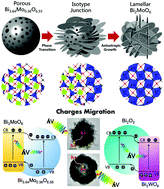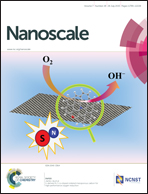Time-dependent evolution of the Bi3.64Mo0.36O6.55/Bi2MoO6 heterostructure for enhanced photocatalytic activity via the interfacial hole migration†
Abstract
Hierarchical Bi3.64Mo0.36O6.55/Bi2MoO6 isotype heterostructures were successfully prepared via a one-pot hydrothermal route by using Bi2O3 porous nanospheres as a sacrificial template. By tuning the reaction time, the formation process of the Bi3.64Mo0.36O6.55/Bi2MoO6 heterostructure involving Mo etching, phase transition and anisotropic growth was clearly identified. More importantly, the Bi3.64Mo0.36O6.55/Bi2MoO6 heterostructure displayed remarkably enhanced photocatalytic activity for dye photodegradation than pure phase bismuth molybdate due to the efficient electron–hole separation and the interfacial photogenerated hole migration from inside the Bi3.64Mo0.36O6.55 layer to outside the Bi2MoO6 layer. The opposite hole migration from the outer layer to the inner layer was also detected in Bi2O3/Bi2WO6 heterostructures, which resulted in the decrease of photocatalytic activity, further verifying the importance of hole migration direction. This work provides a novel route to fabricate heterostructured photocatalysts, as well as gives a strategy for mediating the charge migration to improve photocatalytic performance.



 Please wait while we load your content...
Please wait while we load your content...